FORD CONTOUR 1999 2.G Owners Manual
Manufacturer: FORD, Model Year: 1999, Model line: CONTOUR, Model: FORD CONTOUR 1999 2.GPages: 244, PDF Size: 2.26 MB
Page 181 of 244
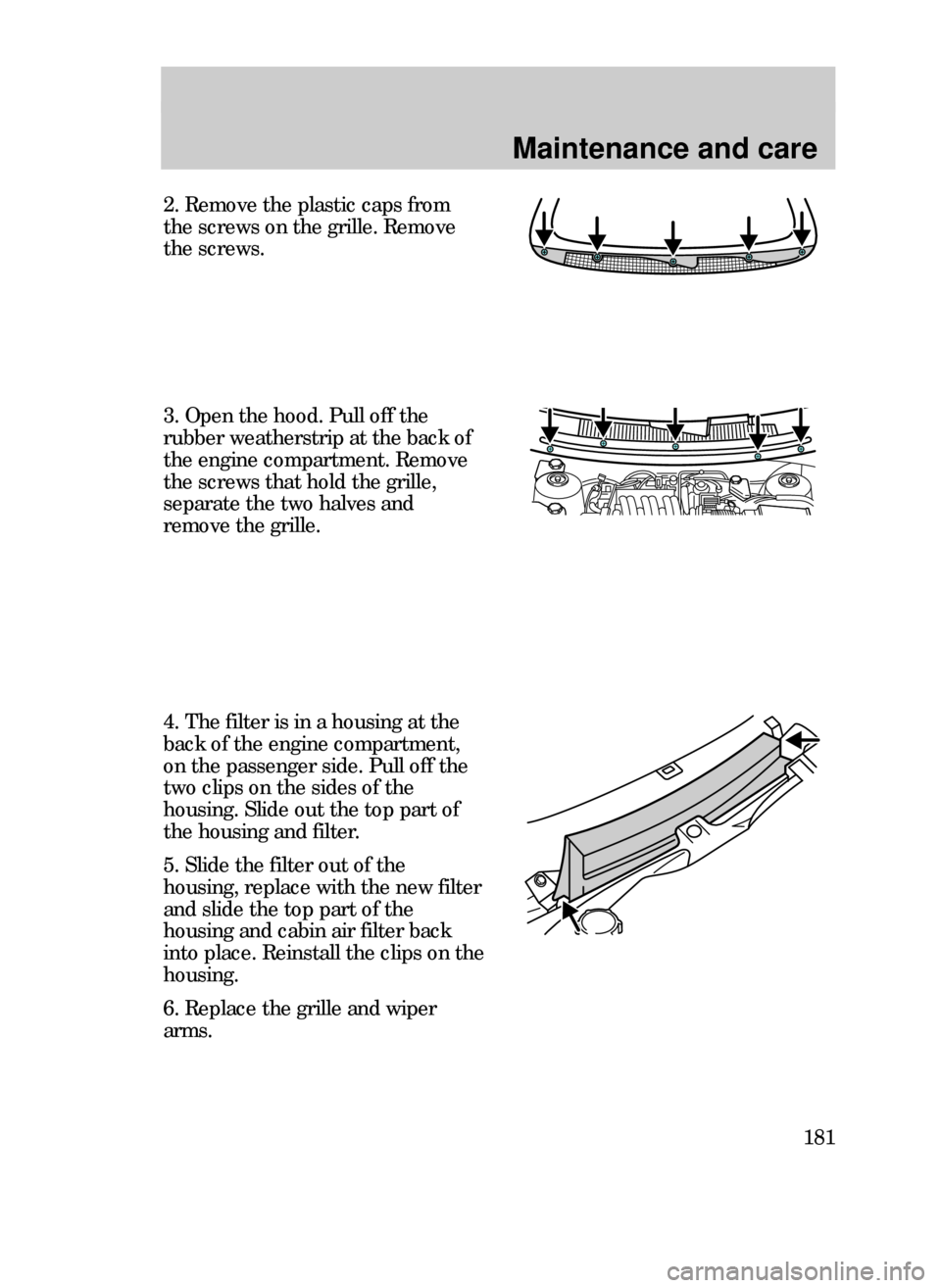
Maintenance and care
181
2. Remove the plastic caps from
the screws on the grille. Remove
the screws.
3. Open the hood. Pull off the
rubber weatherstrip at the back of
the engine compartment. Remove
the screws that hold the grille,
separate the two halves and
remove the grille.
4. The filter is in a housing at the
back of the engine compartment,
on the passenger side. Pull off the
two clips on the sides of the
housing. Slide out the top part of
the housing and filter.
5. Slide the filter out of the
housing, replace with the new filter
and slide the top part of the
housing and cabin air filter back
into place. Reinstall the clips on the
housing.
6. Replace the grille and wiper
arms.
31CMCen 3/25/99 3:45 PM Page 181
Page 182 of 244
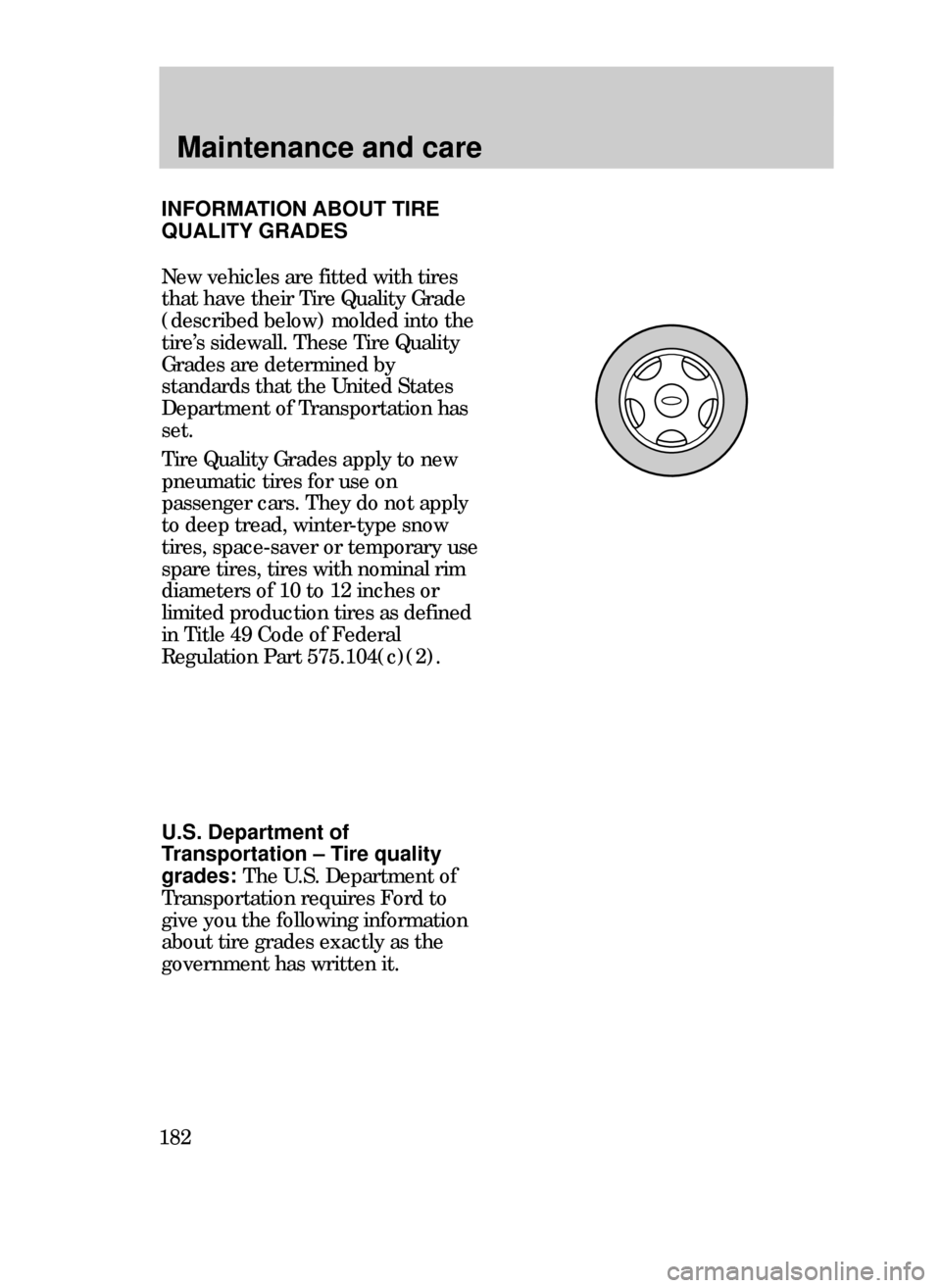
Maintenance and care
182New vehicles are fitted with tires
that have their Tire Quality Grade
(described below) molded into the
tireÕs sidewall. These Tire Quality
Grades are determined by
standards that the United States
Department of Transportation has
set.
Tire Quality Grades apply to new
pneumatic tires for use on
passenger cars. They do not apply
to deep tread, winter-type snow
tires, space-saver or temporary use
spare tires, tires with nominal rim
diameters of 10 to 12 inches or
limited production tires as defined
in Title 49 Code of Federal
Regulation Part 575.104(c)(2).
U.S. Department of
Transportation Ð Tire quality
grades: The U.S. Department of
Transportation requires Ford to
give you the following information
about tire grades exactly as the
government has written it.
INFORMATION ABOUT TIRE
QUALITY GRADES
31CMCen 3/25/99 3:45 PM Page 182
Page 183 of 244
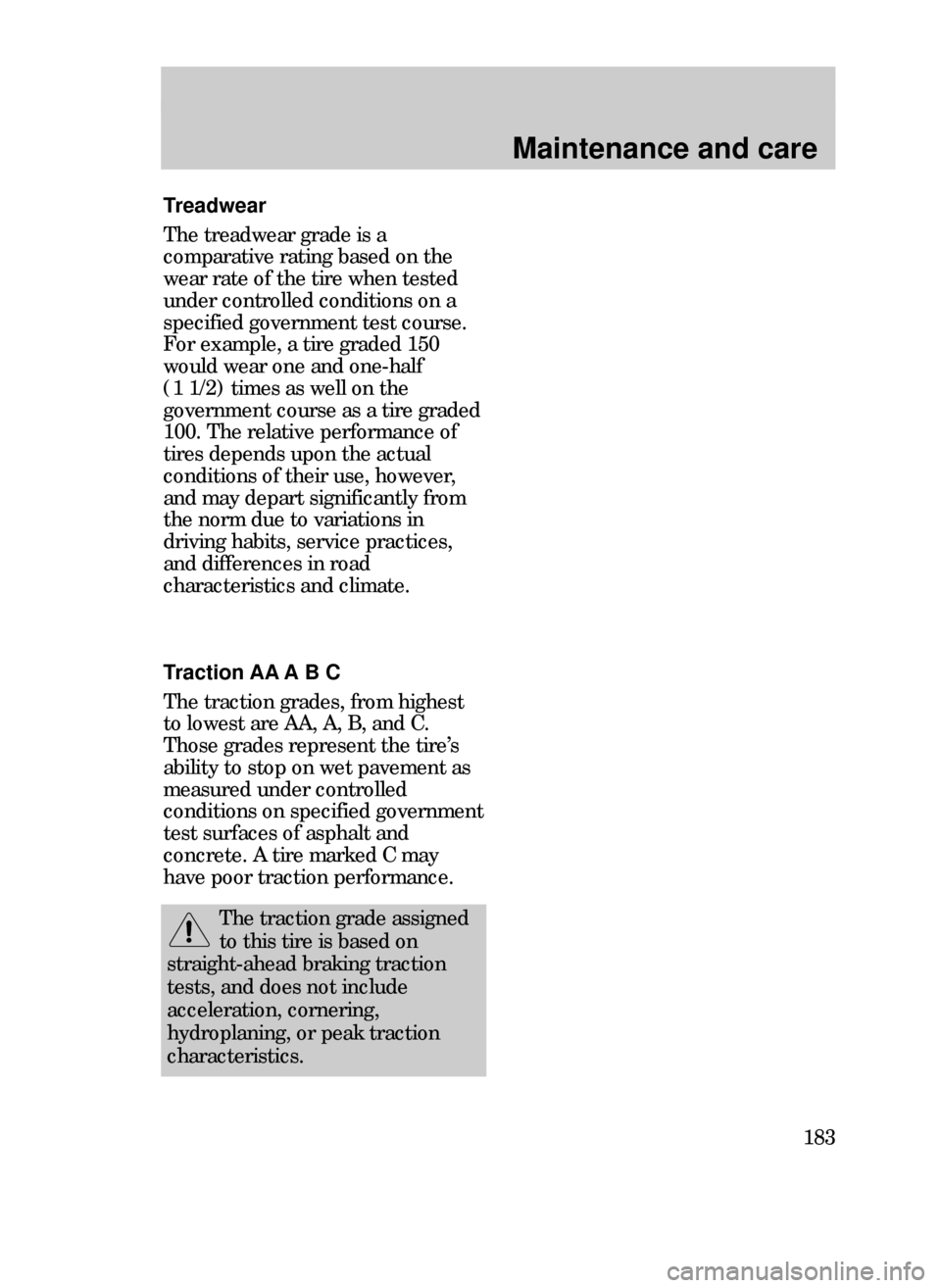
Maintenance and care
183
Treadwear
The treadwear grade is a
comparative rating based on the
wear rate of the tire when tested
under controlled conditions on a
specified government test course.
For example, a tire graded 150
would wear one and one-half
(1 1/2) times as well on the
government course as a tire graded
100. The relative performance of
tires depends upon the actual
conditions of their use, however,
and may depart significantly from
the norm due to variations in
driving habits, service practices,
and differences in road
characteristics and climate.
Traction AA A B C
The traction grades, from highest
to lowest are AA, A, B, and C.
Those grades represent the tireÕs
ability to stop on wet pavement as
measured under controlled
conditions on specified government
test surfaces of asphalt and
concrete. A tire marked C may
have poor traction performance.
The traction grade assigned
to this tire is based on
straight-ahead braking traction
tests, and does not include
acceleration, cornering,
hydroplaning, or peak traction
characteristics.
31CMCen 3/25/99 3:45 PM Page 183
Page 184 of 244
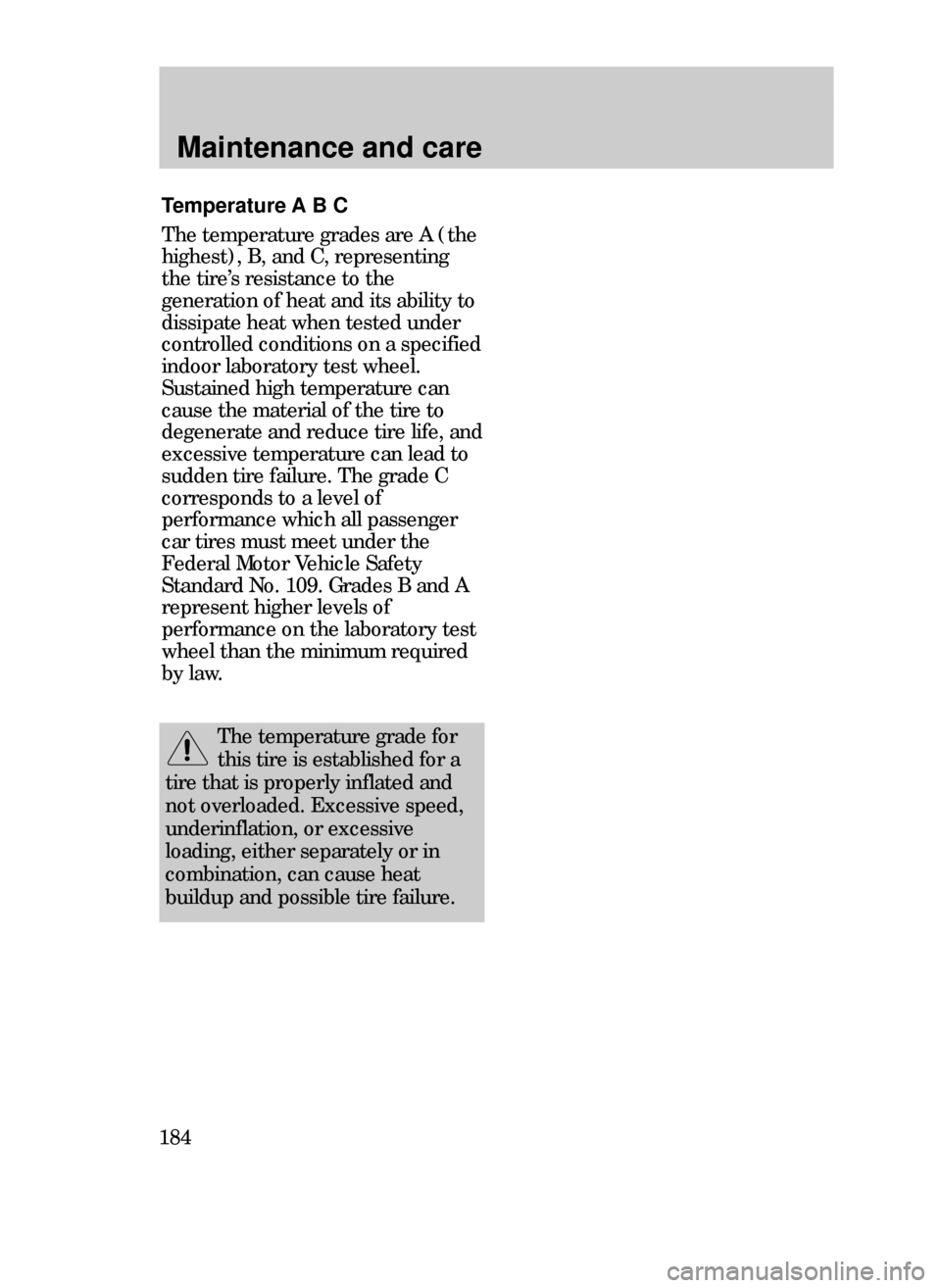
Maintenance and care
184
Temperature A B C
The temperature grades are A (the
highest), B, and C, representing
the tireÕs resistance to the
generation of heat and its ability to
dissipate heat when tested under
controlled conditions on a specified
indoor laboratory test wheel.
Sustained high temperature can
cause the material of the tire to
degenerate and reduce tire life, and
excessive temperature can lead to
sudden tire failure. The grade C
corresponds to a level of
performance which all passenger
car tires must meet under the
Federal Motor Vehicle Safety
Standard No. 109. Grades B and A
represent higher levels of
performance on the laboratory test
wheel than the minimum required
by law.
The temperature grade for
this tire is established for a
tire that is properly inflated and
not overloaded. Excessive speed,
underinflation, or excessive
loading, either separately or in
combination, can cause heat
buildup and possible tire failure.
31CMCen 3/25/99 3:45 PM Page 184
Page 185 of 244
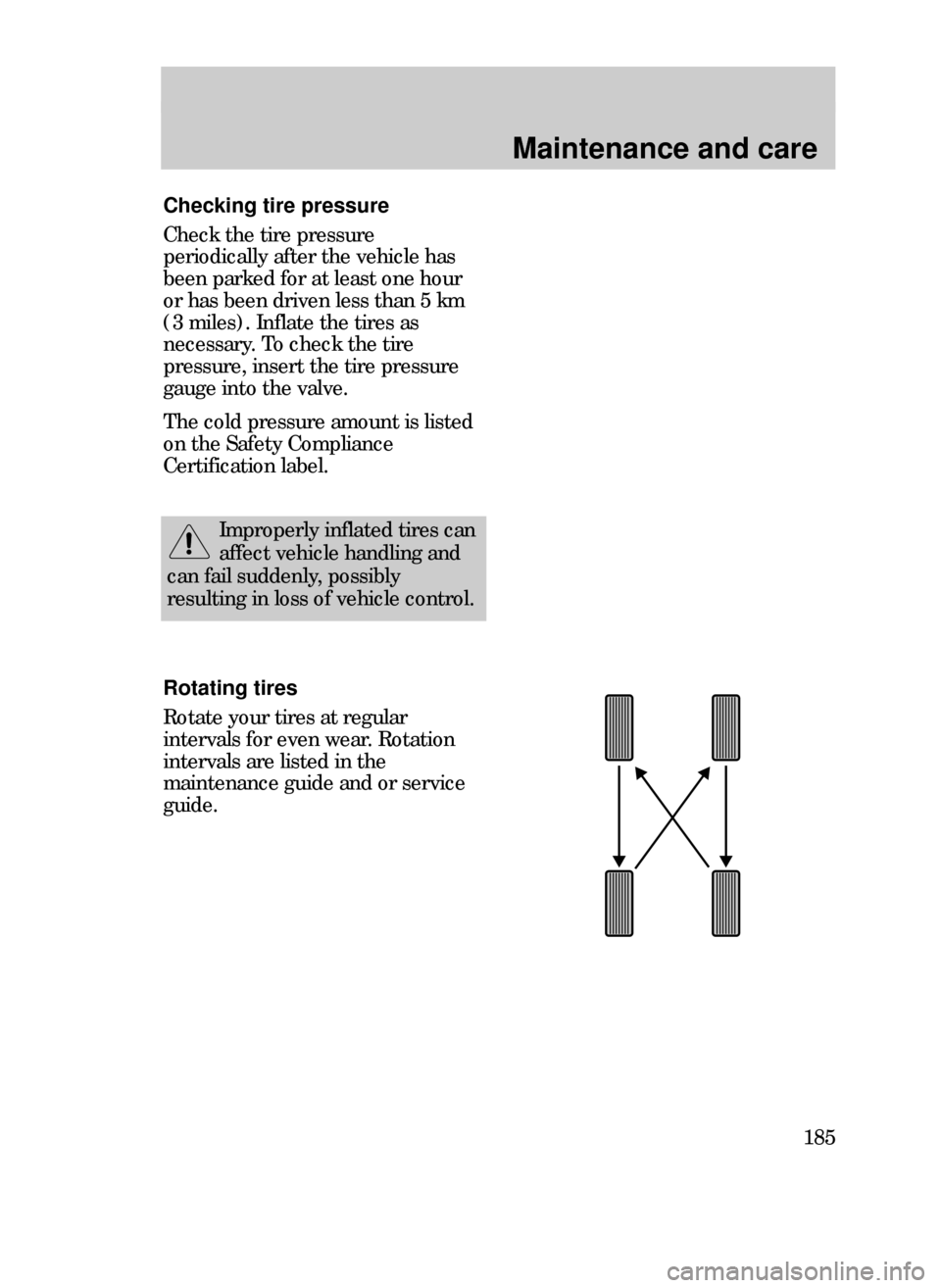
Maintenance and care
185
Checking tire pressure
Check the tire pressure
periodically after the vehicle has
been parked for at least one hour
or has been driven less than 5 km
(3 miles). Inflate the tires as
necessary. To check the tire
pressure, insert the tire pressure
gauge into the valve.
The cold pressure amount is listed
on the Safety Compliance
Certification label.
Improperly inflated tires can
affect vehicle handling and
can fail suddenly, possibly
resulting in loss of vehicle control.
Rotating tires
Rotate your tires at regular
intervals for even wear. Rotation
intervals are listed in the
maintenance guide and or service
guide.
31CMCen 3/25/99 3:45 PM Page 185
Page 186 of 244
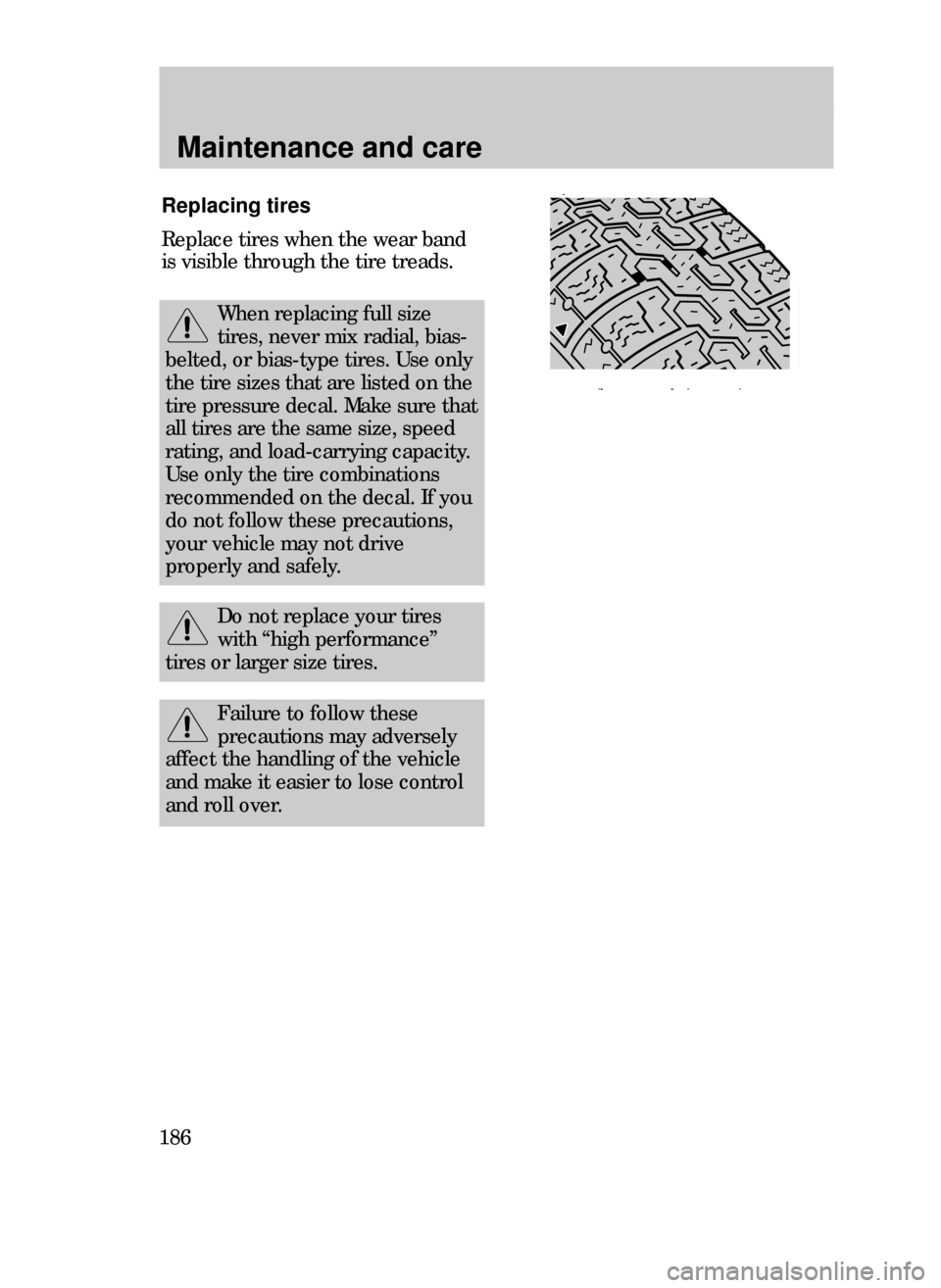
Maintenance and care
186
Failure to follow these
precautions may adversely
affect the handling of the vehicle
and make it easier to lose control
and roll over.
Replacing tires
Replace tires when the wear band
is visible through the tire treads.
When replacing full size
tires, never mix radial, bias-
belted, or bias-type tires. Use only
the tire sizes that are listed on the
tire pressure decal. Make sure that
all tires are the same size, speed
rating, and load-carrying capacity.
Use only the tire combinations
recommended on the decal. If you
do not follow these precautions,
your vehicle may not drive
properly and safely.
Do not replace your tires
with Òhigh performanceÓ
tires or larger size tires.
31CMCen 3/25/99 3:45 PM Page 186
Page 187 of 244
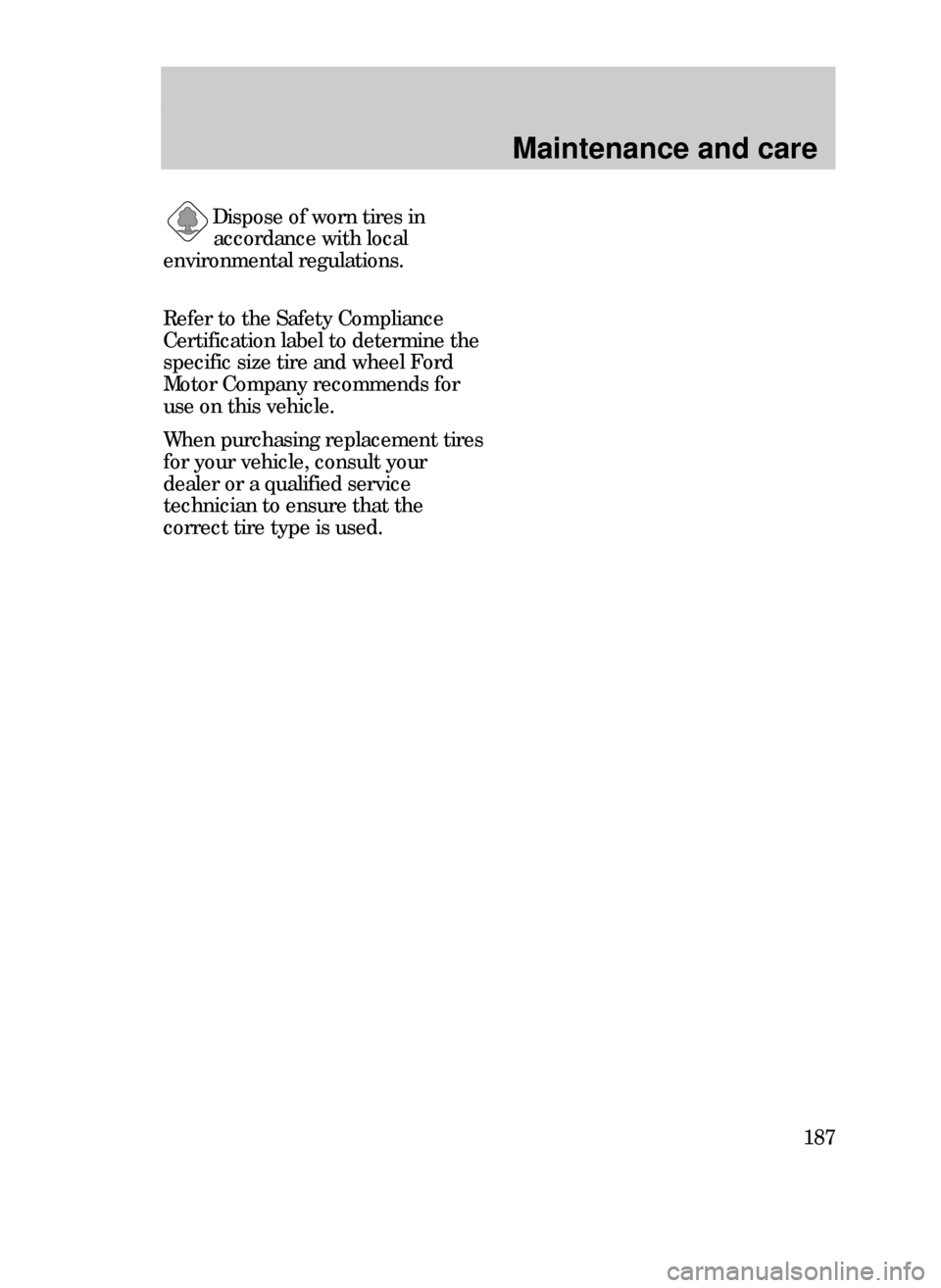
Maintenance and care
187 Dispose of worn tires in
accordance with local
environmental regulations.
Refer to the Safety Compliance
Certification label to determine the
specific size tire and wheel Ford
Motor Company recommends for
use on this vehicle.
When purchasing replacement tires
for your vehicle, consult your
dealer or a qualified service
technician to ensure that the
correct tire type is used.
31CMCen 3/25/99 3:45 PM Page 187
Page 188 of 244
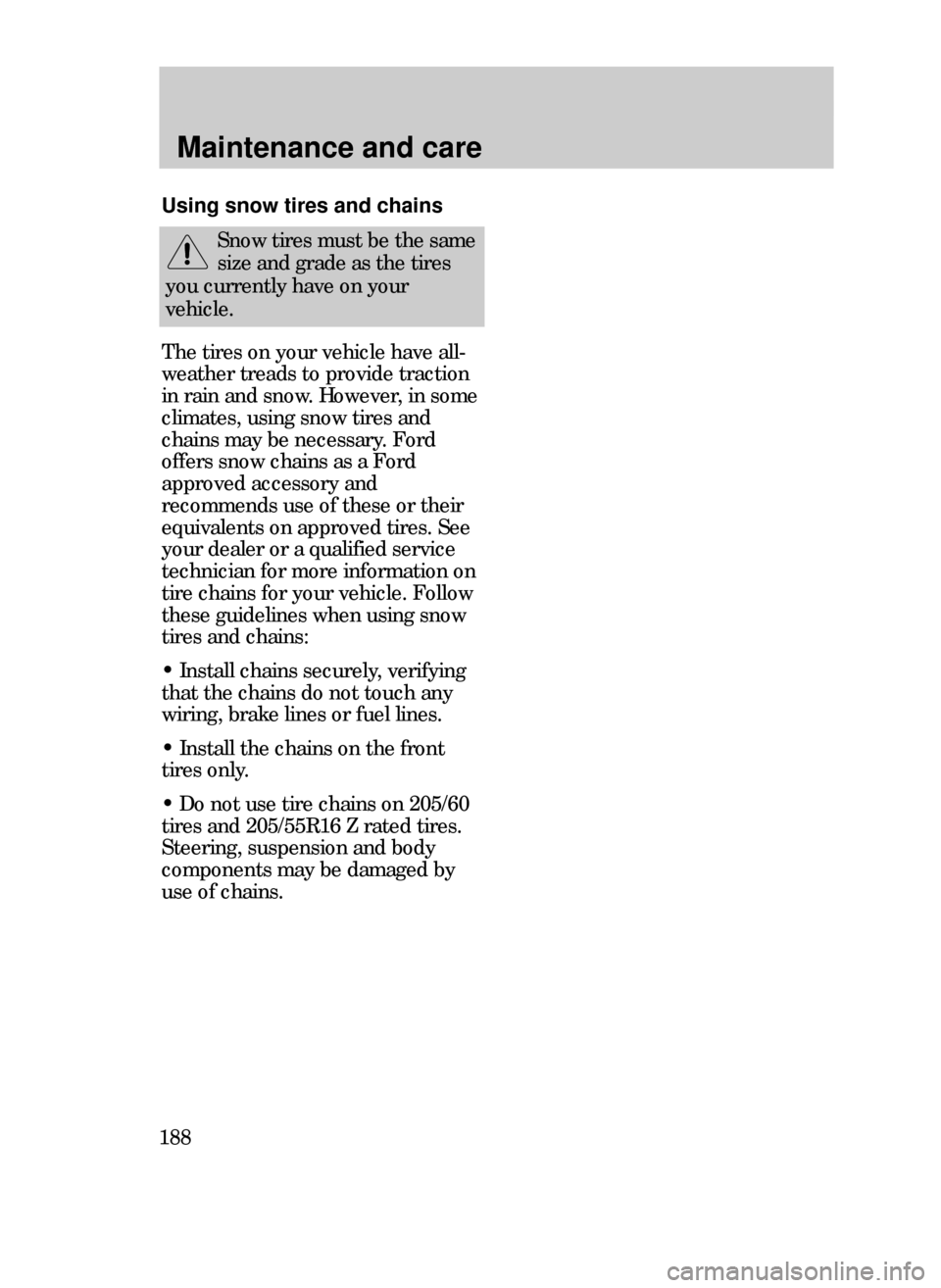
Maintenance and care
188
The tires on your vehicle have all-
weather treads to provide traction
in rain and snow. However, in some
climates, using snow tires and
chains may be necessary. Ford
offers snow chains as a Ford
approved accessory and
recommends use of these or their
equivalents on approved tires. See
your dealer or a qualified service
technician for more information on
tire chains for your vehicle. Follow
these guidelines when using snow
tires and chains:
¥ Install chains securely, verifying
that the chains do not touch any
wiring, brake lines or fuel lines.
¥ Install the chains on the front
tires only.
¥ Do not use tire chains on 205/60
tires and 205/55R16 Z rated tires.
Steering, suspension and body
components may be damaged by
use of chains.
Snow tires must be the same
size and grade as the tires
you currently have on your
vehicle.
Using snow tires and chains
31CMCen 3/25/99 3:45 PM Page 188
Page 189 of 244
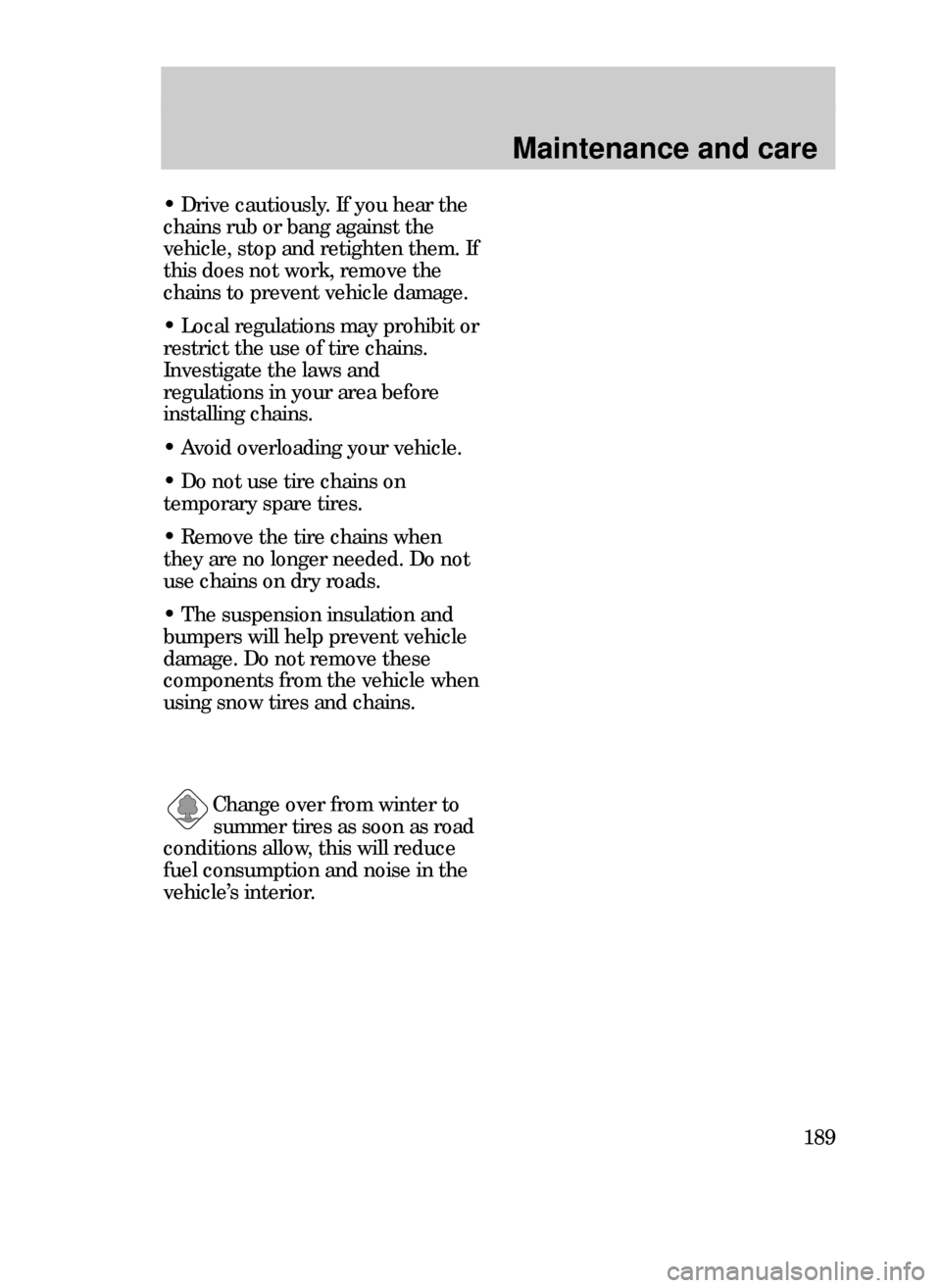
Maintenance and care
189
Change over from winter to
summer tires as soon as road
conditions allow, this will reduce
fuel consumption and noise in the
vehicleÕs interior.
¥ Drive cautiously. If you hear the
chains rub or bang against the
vehicle, stop and retighten them. If
this does not work, remove the
chains to prevent vehicle damage.
¥ Local regulations may prohibit or
restrict the use of tire chains.
Investigate the laws and
regulations in your area before
installing chains.
¥ Avoid overloading your vehicle.
¥ Do not use tire chains on
temporary spare tires.
¥ Remove the tire chains when
they are no longer needed. Do not
use chains on dry roads.
¥ The suspension insulation and
bumpers will help prevent vehicle
damage. Do not remove these
components from the vehicle when
using snow tires and chains.
31CMCen 3/25/99 3:45 PM Page 189
Page 190 of 244
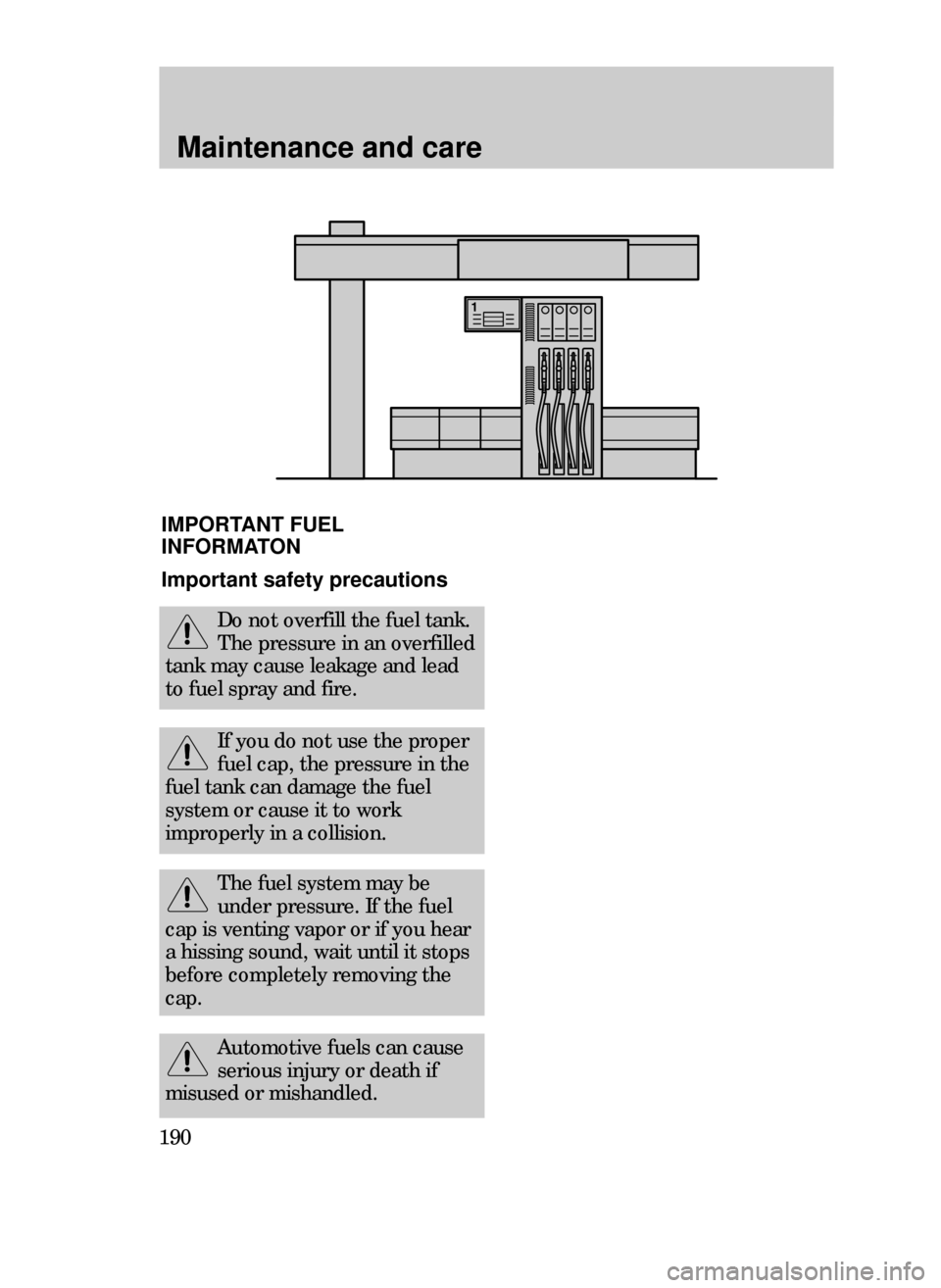
Maintenance and care
190
Automotive fuels can cause
serious injury or death if
misused or mishandled.
IMPORTANT FUEL
INFORMATON
Important safety precautions
Do not overfill the fuel tank.
The pressure in an overfilled
tank may cause leakage and lead
to fuel spray and fire.
If you do not use the proper
fuel cap, the pressure in the
fuel tank can damage the fuel
system or cause it to work
improperly in a collision.
The fuel system may be
under pressure. If the fuel
cap is venting vapor or if you hear
a hissing sound, wait until it stops
before completely removing the
cap.
31CMCen 3/25/99 3:45 PM Page 190